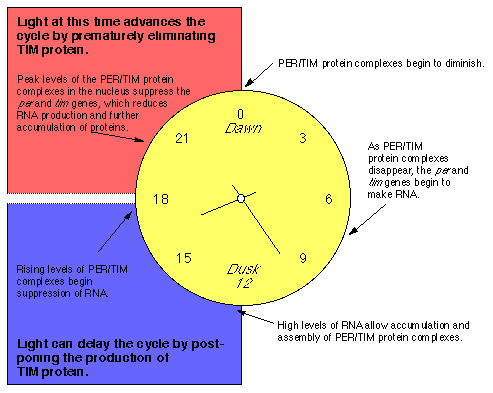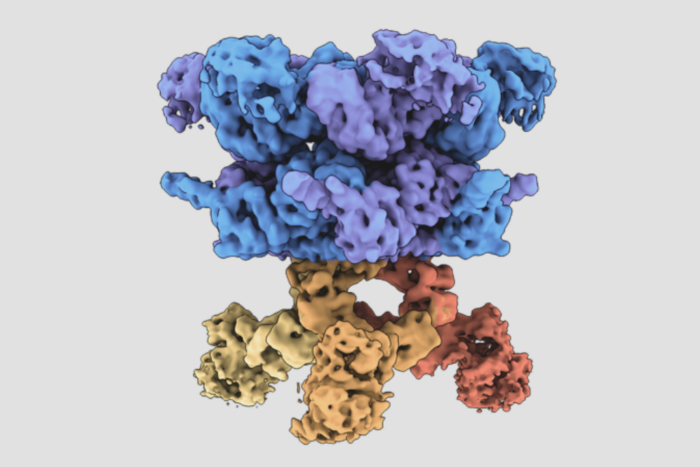Light Sets the Molecular Controls of Circadian Rhythm
Light sets the circadian rhythm by eliminating a key protein needed for the molecular mechanism of the body’s clock, according to scientists in the March 22 Science. The findings, from fruit fly studies, may help explain light’s effect on the daily cycle that influences sleep, mental alertness, pain sensitivity and temperature and hormone levels.
“Plants and animals, including insects, adjust their intrinsic circadian cycles, which can range from about 23 to 25 hours, to the 24-hour solar day. We have identified a molecular key to light’s control in flies and expect to find a similar mechanism in humans, which may explain how people adjust their body clocks after traveling across time zones,” says Michael W. Young, Ph.D., professor and director of the Laboratory of Genetics(opens in new window) at The Rockefeller University and an investigator at the Howard Hughes Medical Institute(opens in new window) (HHMI). Young also directs the National Science Foundation (NSF) Science and Technology Center for Biological Timing at Rockefeller.
Both fruit flies and humans have activity rhythms that adapt perfectly to a 24-hour cycle of night and day or can be set to new time zones by light. The influence of light is quite strong, Young and his coinvestigators note. For example, fruit flies raised in total darkness maintain an activity rhythm of about 23.5 hours, but a brief period in light can either delay or advance the cycle, depending on the timing of the light exposure within the cycle.
In the fly, the rhythm is set by the action of two proteins, PER and TIM, made by the period (per) andtimeless (tim) genes, respectively. All cells of the fly have per and tim genes, but the brain cells set the body clock. PER and TIM proteins accumulate in the nuclei of eye cells sensitive to light, called photoreceptors, as well as pacemaker cells of the central brain. Scientists at the California Institute of Technology discovered per in 1971, while Young’s group identified tim in 1994.
The fly circadian cycle begins around noon when the per and tim genes transcribe their DNA into RNA, molecules essential to create the PER and TIM proteins, but only after sunset does the accumulated RNA prompt the cell to stockpile the PER and TIM proteins. At night, the proteins pair and migrate into the nucleus, home to cells’ genetic material. About four hours before dawn, the level of PER/TIM protein complexes peaks, which signals the per and tim genes to stop making RNA and, hence, the protein complexes. Near dawn, the PER/TIM protein complexes disintegrate. With the complexes depleted, theper and tim genes begin to make RNA again by midday.
The scientists found that the TIM and PER proteins need each other to get into the nucleus. However, if flies are exposed to light, one of the proteins, TIM, rapidly degrades, which blocks the movement of the remaining protein to the nucleus.
“In the natural environment, even though RNA levels have been rising since midday, sunlight keeps TIM protein from accumulating until nightfall,” explains Young. “This postponement delays the binding and nuclear activity of the PER and TIM proteins until the night part of the cycle.”
The findings also suggest how light exposure at the different times of day adapts the rhythm, such as adjusting to a new time zone. For example, Young and his colleagues found that flies exposed to one hour of daylight in the evening, around 10 p.m., delayed the normal night time accumulation of the TIM protein, and postponed the behavioral cycle by four to five hours, as if the fly were adapting to westward travel. TIM proteins did accumulate later, in keeping with the observed behavioral delay, Young notes.
In contrast, flies exposed to daylight an hour before dawn prematurely lost their TIM proteins, which did not reappear until the following afternoon. This light exposure advanced the behavioral rhythm of the flies by one to two hours, an adaptation expected for flies traveling east.

Earlier research hinted that TIM proteins might be sensitive to light, says Young. When exposed to constant light fruit flies lose their circadian rhythms and do not accumulate or process PER proteins normally. While not directly affecting the PER protein, constant light continuously eliminates the TIM protein to block the fly’s rhythms. Constant light suppresses circadian rhythms in a variety of organisms including mammals, Young notes.
Young’s coauthors include Michael P. Myers, Ph.D., Karen Wagner-Smith, M. Phil., and Adrian Rothenfluh-Hilfiker, Dipl. Myers and Wagner-Smith also have HHMI appointments. HHMI and NSF supported the studies.


